Wondering what the difference is between referring domains vs backlinks?
If you’re working on website SEO, you’ve probably seen these terms. And you may know that backlinks are a significant ranking factor.
In this article, we’ll explain the differences between referring domains vs backlinks. And we’ll explain how they impact SEO.
In This Article
What Are Backlinks?
Backlinks are hyperlinks from other websites to yours. In everyday conversation, people may use the term “link” instead.
For example, if we linked to your website from this article page, you could say:
- I got a backlink from aioseo.com, or,
- I got a link from aioseo.com.
Backlinks are a prominent topic in SEO because they’re a ranking factor.
If you obtain a significant number of links from trusted websites, it can increase your sales and revenue.
Backlink Quality Matters for Rankings
But quality is key.
- Backlinks from low-quality sites can hurt your rankings.
- Backlinks from respected websites can boost your rankings.
So, what’s considered a low-quality backlink?
- Links from spurious sites like financial scam sites, sites selling illegal drugs, or sites involved in link schemes.
- Backlinks from odd websites, like those with almost no content or gibberish content.
And what’s considered a high-quality link?
- Links from trusted institutions like government, universities, medical centers, industry and business associations, or mainstream media.
- Links from established businesses and subject matter experts.
How Do I Find Out What Backlinks My Site Has?
To find out what backlinks your website has, create a free account with Ahrefs and log in.
At the top left, enter your domain’s URL.

Now, you’ll see a dashboard with top indicators including your total number of backlinks.
Click on Backlinks to view each individual backlink your site has.
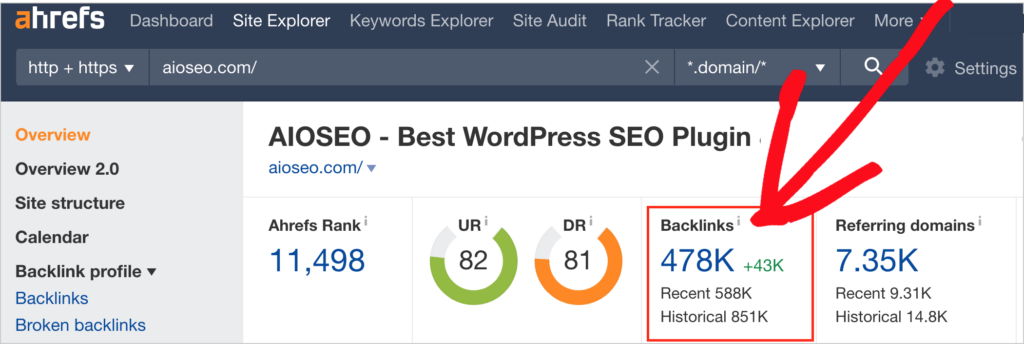
Now, what’s the difference between backlinks and referring domains?
Referring Domains vs Backlinks
A referring domain is a website that has linked to your site; the backlink is the URL of the specific page that has linked to you.
So, if we link to WPForms.com from this page:
- The referring domain would be aioseo.com.
- The backlink would be this page URL: aioseo.com/referring-domains-vs-backlinks-seo
In our example in the previous section, we saw that AIOSEO.com has:
- 478k backlinks.
Looking at that same Ahrefs dashboard, we can that AIOSEO.com has:
- 7.35k referring domains.
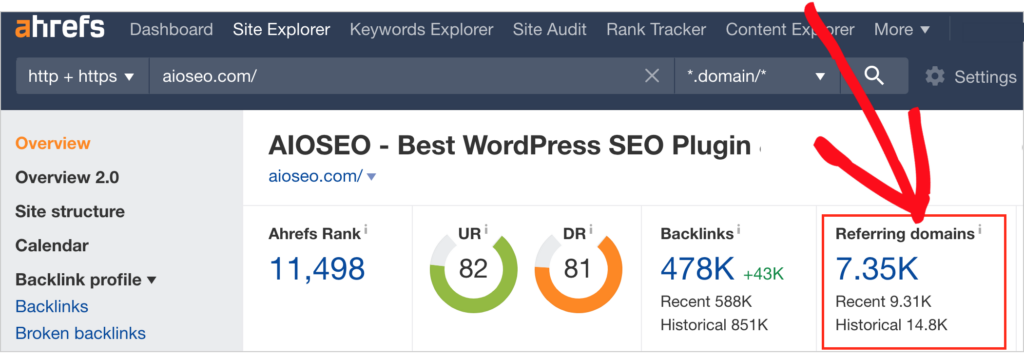
Notice that AIOSEO’s number of referring domains is less than the number of backlinks. This is common. It means that some websites link multiple times to the same website.
Domain Authority and Domain Ratings
Before we look at Ahrefs Referring Domains report, take another look at the dashboard.
You’ll see there’s a “DR” score, out of 100. DR stands for “Domain Rating.”
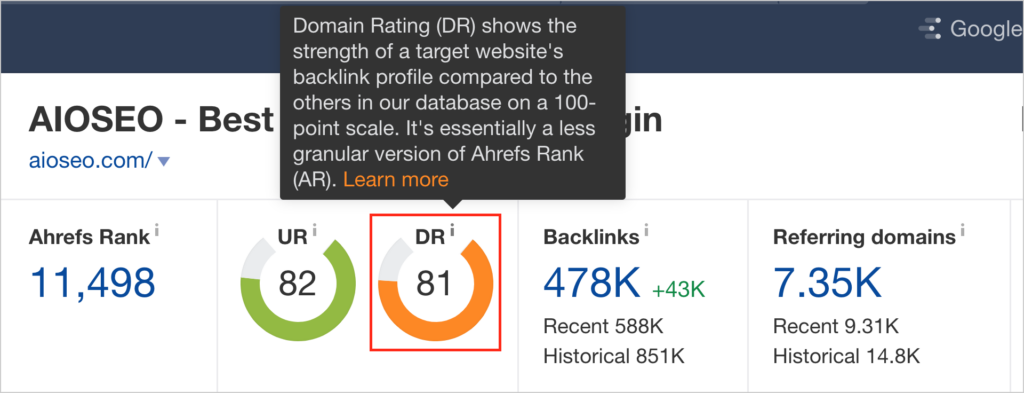
This is a proprietary score, measured on a logarithmic scale, that serves as a useful proxy for the quality of a website (domain).
Semrush, software similar to Ahrefs, provides a similar score called “Authority Score.”
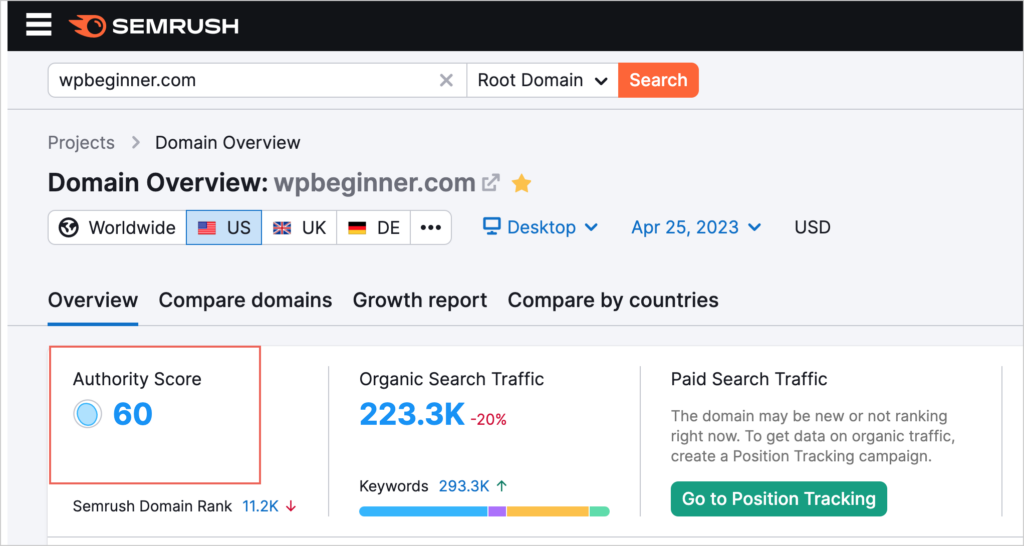
The score is intended to help marketing professionals identify high-quality websites.
Domain scores are useful when assessing the quality of a site’s backlink profile and identifying sites to target in campaigns.
But these scores aren’t perfect. For example, it’s possible for domains with a high score to expire, and be purchased by people who then use them for link schemes.
Google’s algorithms don’t use domain authority scores.
Referring Domains Report
Now let’s look at Ahrefs’ Referring Domains Report which you can access by clicking on that referring domains number.
You’ll see a complete list of all domains that have linked to yours. And this sortable list, by default, ranks these domains according to their Domain Rating score.
So at the top of our list of referring domains we see sites with Domain Rating (DR) scores of 90+, including WordPress.org and Github.com.
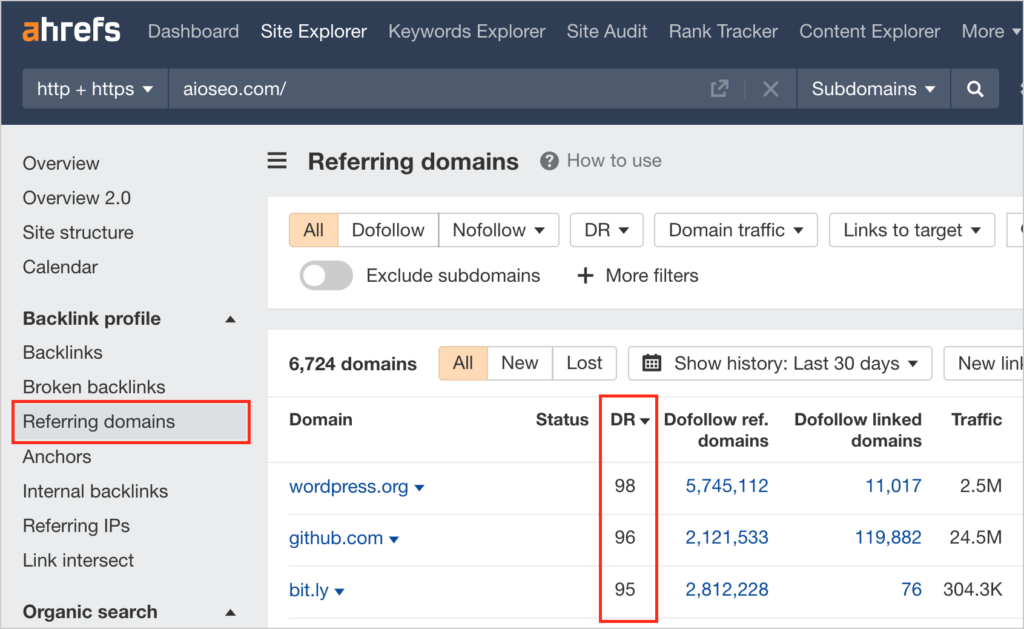
Role of Backlinks in Link Building
Because quality backlinks can mean more traffic and revenue, many businesses hire marketers to run link building campaigns.
A link building campaign is simply any activity designed to increase backlinks to a website.
These campaigns can range from writing guest articles for industry websites all the way up to complex processes involving multiple software platforms and proprietary methods.
Regardless of the link building strategy involved, marketers prize backlinks from high-quality sites.
But why do these links impact SEO?
Impact on SEO
Google views backlinks from trusted sites as a vote of confidence in your site. It’s like an endorsement.
As more sites give yours that confidence vote, your site’s pages will likely start to rank higher in search results. Benefits include increases in:
- Referral traffic (traffic coming from the linking sites)
- Organic traffic (from elevated search rankings)
- Conversions and revenue.
In addition, a website with a strong backlink profile can command top dollar in the resale marketplace.
Backlinks and Big Money
A strong backlink profile is one factor that attracts corporate buyers or angel investors to personal websites.
Classic car buff Randy Nonnenberg turned his BringATrailer.com blog into a $1 billion marketplace. Notice the strong backlink numbers.

Hearst Autos acquired BringATrailer in June 2020, at the height of the pandemic. At the time, the site had a strong backlink profile.
Since the acquisition, the site has quintupled its referring domains number, an indication that the new owners are prioritizing link building.
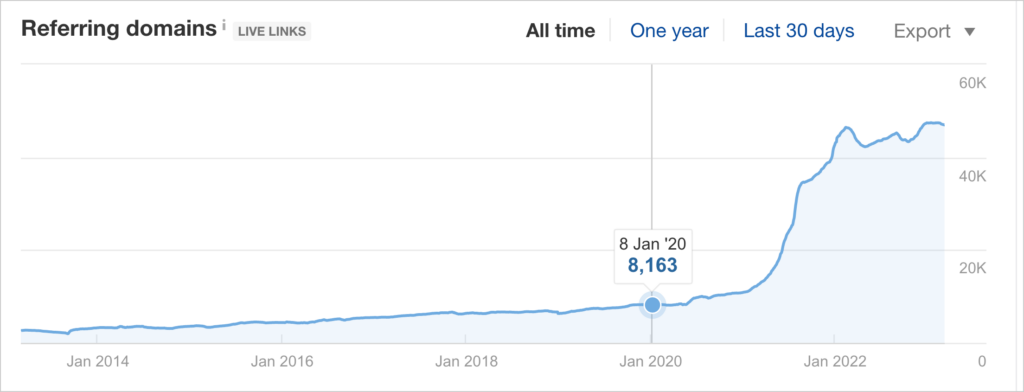
This hockey stick pattern showing little growth followed by a dramatic spike in referring domains to a site, isn’t uncommon.
The CleverGirlFinance.com blog only had 165 referring domains in 2018, and now they’re at 7.54k with 211k backlinks and a total monthly traffic value of $203k.

What’s traffic value? This metric means that the site owner would have to spend $203k/month in search advertising to get the same amount (and quality) of traffic she’s getting for free from search engines.
This is the power of SEO.
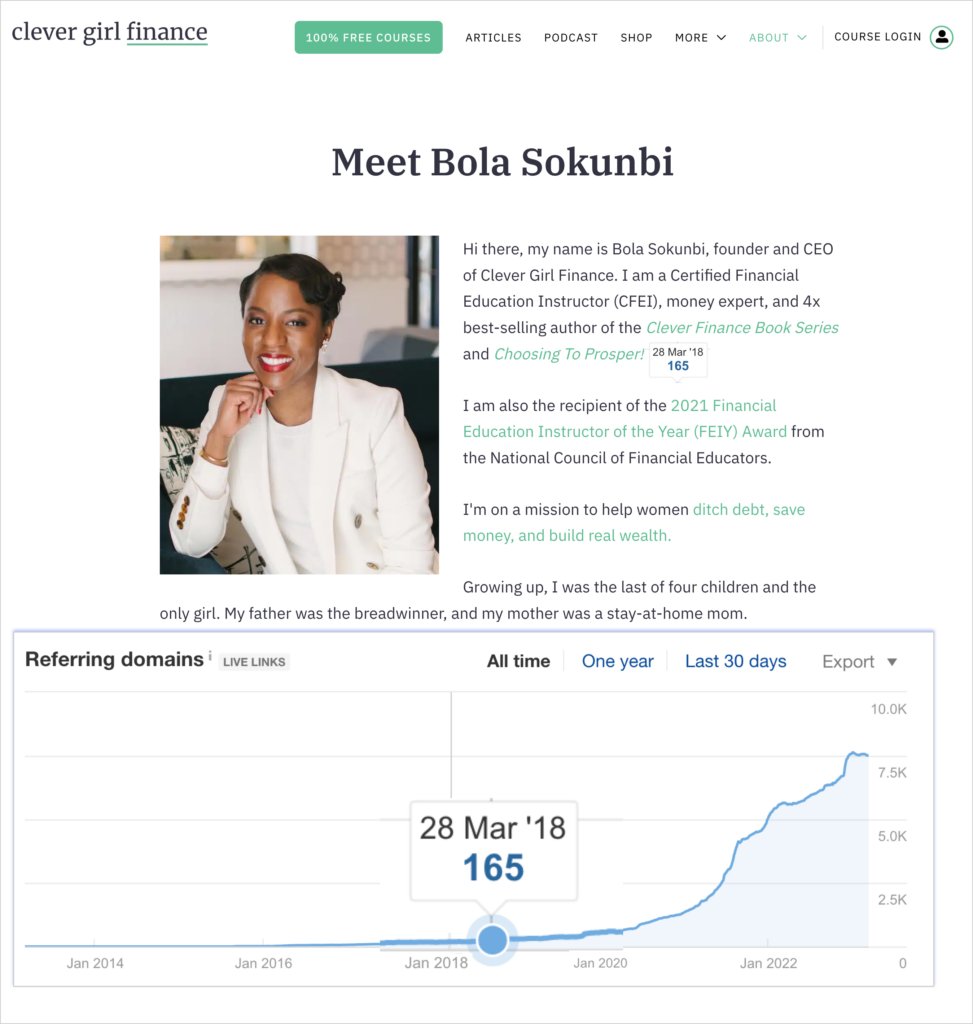
The moral of the story?
- Everyone starts small.
- It takes consistent discipline to grow.
- Persistence matters.
How to Start Building a Backlink Profile
It’s difficult to get backlinks from government or university websites. Some of these sites have policies against linking to commercial enterprises.
Start by getting backlinks from trusted sites you have some relevance to.
Consider these options:
- Small local news sites: Write an OpEd for a local news site in return for a link to your site.
- Industry associations: Whether these are local, regional, or national, consider a membership if you’ll get a link in return. Or offer to write a guest post in return for a backlink.
- Chambers of commerce: Typically chambers offer you a link in an online members’ directory. And there’ll be a fee to join. As you network with the chamber members, consider requesting backlinks as people voice support for your business.
- Community programs and causes: If you support local events or causes, request a backlink in return for your sponsorship.
- Guest blogging: Offer to write a few guest posts for related blogs or industry news sites.
- High-quality content: Start by creating 1-3 high-quality articles for your site. This will attract links.
What to Avoid
- Skip the infographics: Interest in infographics has died down. Plus, they aren’t easy to navigate on mobile phones.
- Don’t guest post for irrelevant sites: If you sell cowboy hats, don’t guest post for a site selling ballet shoes.
- Nofollow links: Learn the difference between nofollow and dofollow links. Nofollow links signal to search engines that the linking site does not endorse your site. So while you’ll get referral traffic from the links, you won’t get any SEO value.
There’s More to SEO Strategy than Just Backlinks
To make the most of SEO impact from backlinks be sure to adopt a sound SEO strategy.
This is where a plugin like All in One SEO (AIOSEO) comes in. Created for WordPress users, it makes technical tasks as easy as clicking some buttons and filling out some form fields.
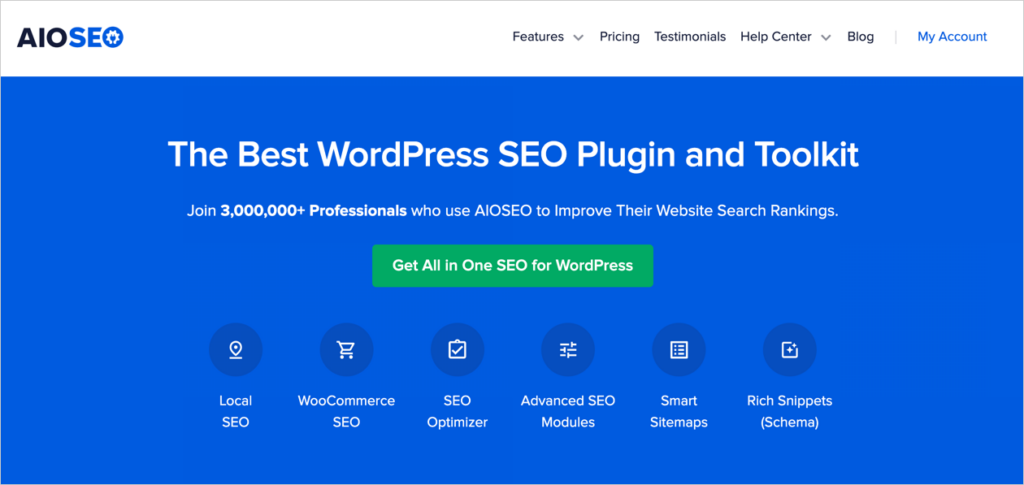
All in One SEO (AIOSEO) is an established plugin with over 3 million users. And it has thousands of 5-star reviews on WordPress.org.
You can download the plugin here.
On-Page SEO
All in One SEO (AIOSEO) analyzes your content for you. For each web page, it provides a beginner-friendly checklist for you to take action on.
Optimizing your content for SEO is a key part of attracting backlinks: as your content rises in search engine rankings, more people will discover it and link to it.
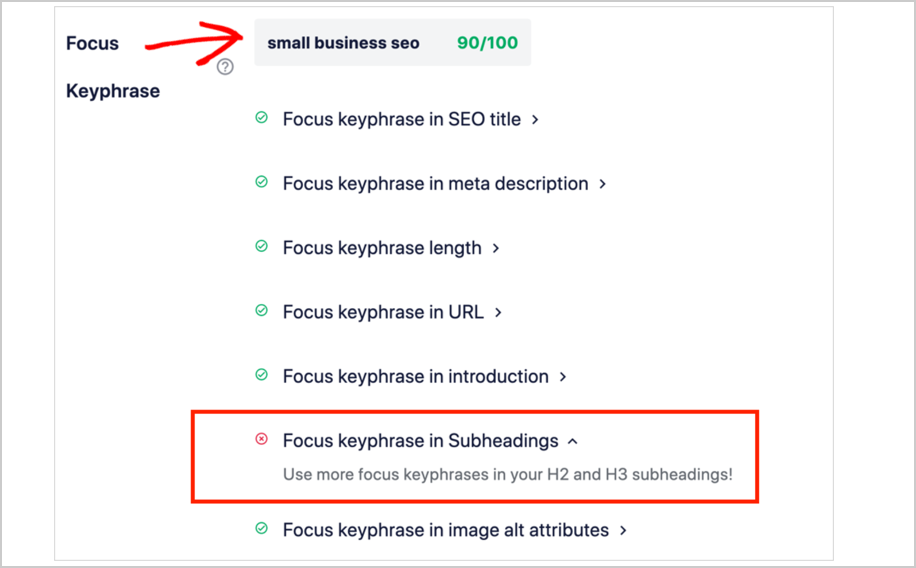
This plugin also provides a click-button way to add schema markup to your web pages. This is code that makes your page eligible to be displayed as a rich snippet in search results.
You can think of rich snippets as super-deluxe search engine displays. Here’s an example.

Internal Links
Internal links play a role in SEO too.
AIOSEO’s Link Assistant (available with the Pro version) makes adding internal links fast and simple.
- Link Assistant will tell you which pages need links.
- It will provide an easy way to add links, without opening the pages.
Pro tips:
- Make sure you have plenty of internal links pointing to your most important pages.
- And deal with orphan pages by adding at least one internal link.
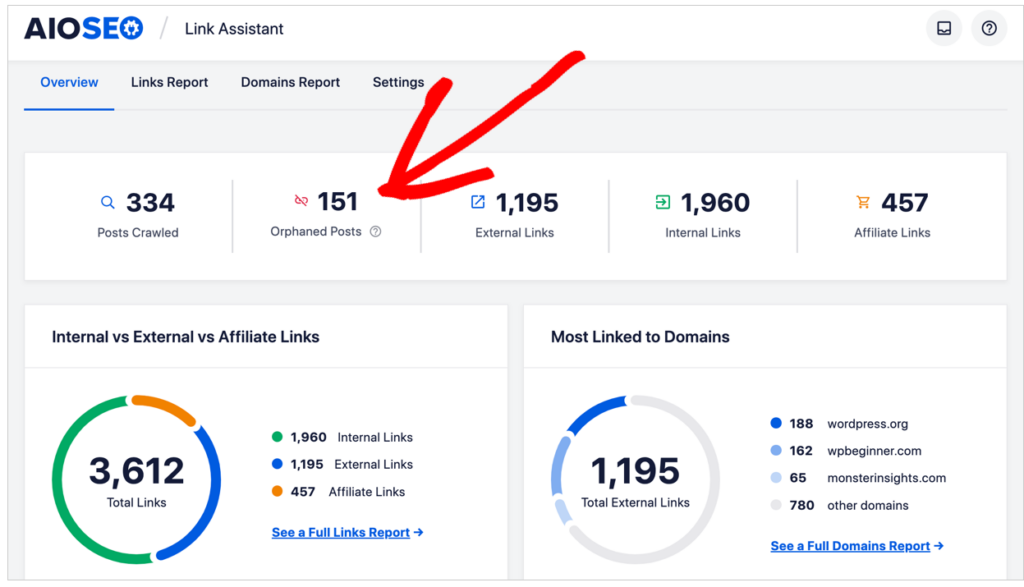
Do Social Media Backlinks Count for SEO?
No, social media backlinks do not contribute to SEO. This is because these links are “nofollow” links. Nofollow links contain code that tells search engines “We don’t endorse the site we’re linking to.”
Social media links, like all inbound links, may provide referral traffic, but they won’t impact search engine rankings.
Bonus Tips
- Use a free tool like Google Analytics to track website metrics. And consider simplifying things by using ExactMetrics or MonsterInsights. These WordPress plugins pull data from Google Analytics and display just what you need to know.
- Bookmark this blog for more search engine optimization and digital marketing tips.
Referring Domains vs Backlinks: Summary
- Both referring domains and backlinks play a role in website rankings, and link building can boost your organic search traffic (i.e., traffic from search engines).
- Focus on getting high-quality backlinks more than on the total number of links.
What’s Next?
We hope this post helped you understand the difference between referring domains vs backlinks and how both can make an impact on your website.
Next, explore this guide to link building and this explainer on nofollow vs dofollow links.
If you found this article helpful, then please subscribe to our YouTube Channel. You’ll find many more helpful tutorials there. You can also follow us on Twitter, LinkedIn, or Facebook to stay in the loop.
Disclosure: Our content is reader-supported. This means if you click on some of our links, then we may earn a commission. We only recommend products that we believe will add value to our readers.
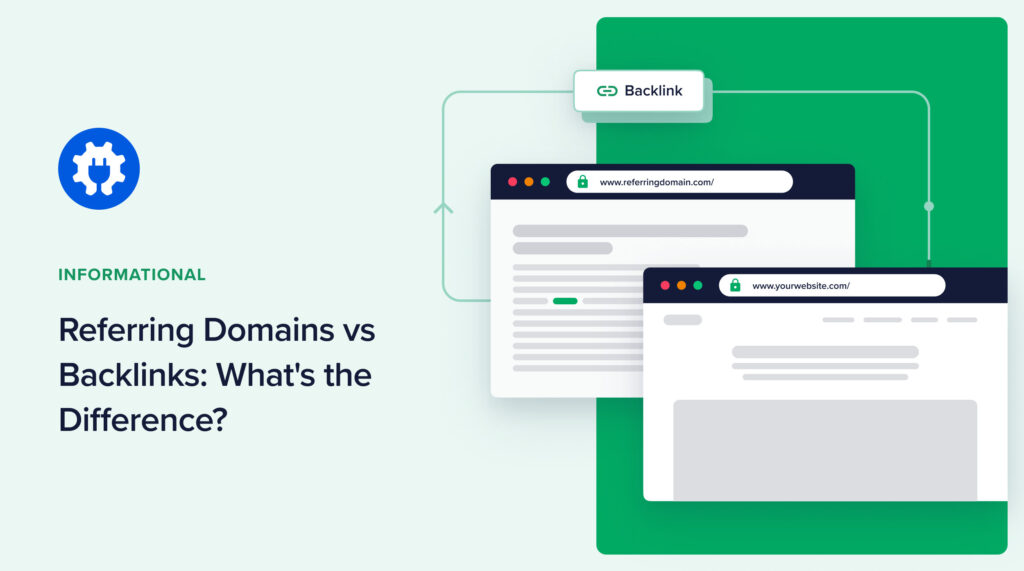

Great article very clear, and I didnt know about the links assistant thats a handy tool.
Thank you, Elisha, for your kind comment. Glad you found it useful.
This was a good read and I found it helpful to understand and realise there are many ways to get traffic to my site. New to this stuff but makes sense. Thanks for the great article.
Hi Dori – Thank you for your feedback. I’m glad you found it helpful. Have a delightful weekend.
Absolutely fascinating breakdown! The distinction between referring domains and backlinks is crucial in understanding the dynamics of SEO. While backlinks indicate the number of incoming links, referring domains signify the unique websites linking to yours, emphasizing diversity and credibility in your site’s network. The impact on SEO is profound; a healthy balance of both metrics can significantly boost rankings and authority. This breakdown clarifies their roles, shedding light on how they collectively contribute to a robust SEO strategy. Great job highlighting this essential aspect of digital marketing!